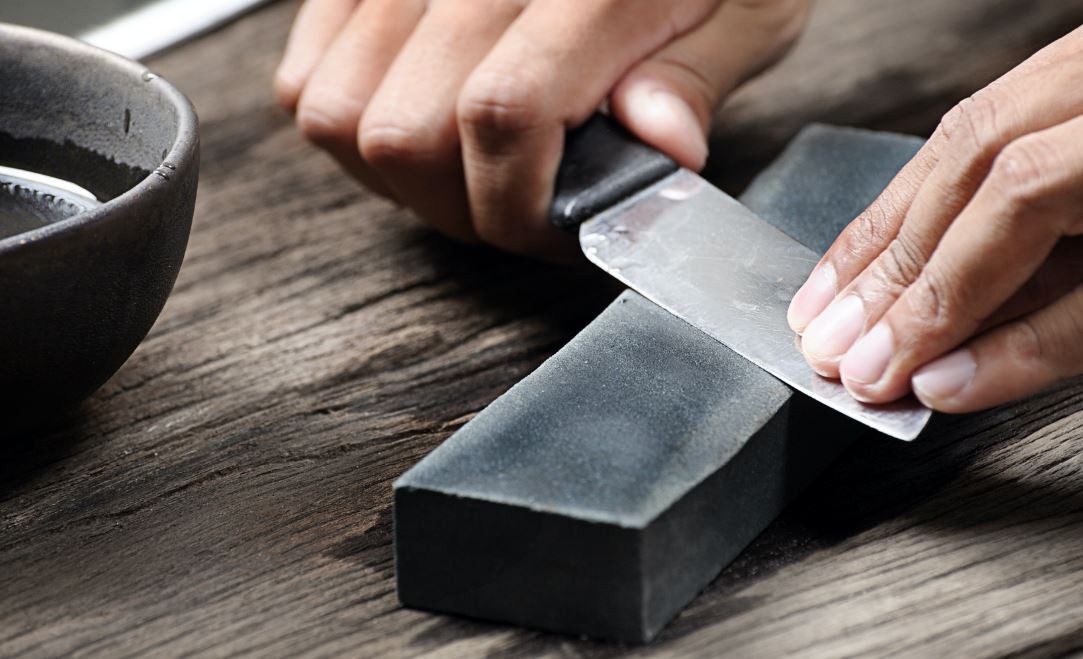Sharpening kitchen knives is a skill that’s fairly easy to learn, and one you’ll never regret acquiring. I sharpen mine on a steel almost every time I cook, and do more intensive sharpening once a month or so, as necessary.
It’s easy to know when a knife needs to be sharpened: it requires more pressure when slicing, and you have less control over it. A really sharp knife glides through ingredients without crushing them. For home cooks, the basic sharpening tools are a steel (despite its name, it is not necessarily made of steel), which you should use almost every time you use the knife because it helps to keep an edge sharp, and a stone (often called a whetstone), which hones a dull blade.
When using either tool, you need to know your knife. First off, what material is it made from? Most kitchen knives tend to be made of carbon steel, stainless steel or carbon-stainless steel. (There are knives made from other alloys and composites but they’re less common, and can be extremely expensive. Knives with ceramic blades need to be re-sharpened with special machines.)
Carbon steel is relatively soft, so it dulls fairly quickly, but it’s easy to sharpen. Like other carbon steel implements (such as skillets or woks), knives made from this metal can react when they come in contact with acidic ingredients (as in when you slice lemons and tomatoes), and they rust easily. After washing a carbon-steel knife – by hand, never in a dishwasher (that goes for all kitchen knives) – dry it immediately.
Stainless steel is a harder metal. A stainless steel knife holds its edge, but it’s difficult to sharpen using home tools. You'll need to take it to a professional sharpener if it gets too dull. A carbon-stainless composite is the best of both worlds – it keeps its edge well and is easy to sharpen.
Then you need to know the angle of the cutting edge. Knives are often divided broadly into two categories: European-style and Japanese-style, although both can be made anywhere. Traditional Japanese blades are sharpened only on one side of the edge, so you need to buy the right one depending on whether you’re left- or right-handed. Single-edged Japanese knives should be sharpened only on the angled side. European-style knives – which can also be made in Japan – are sharp on both sides of the edge, which comes to a narrow, V-like point along its entire length.
Depending on the manufacturer, European blades can be sharpened to a relatively wide or a relatively narrow angle; the former yields a knife that’s sturdy, but not quite as sharp as one honed to an acute angle, which, because it’s thinner, is more fragile. You should sharpen European-style knives at the same angle the manufacturer put on the edge.
Buy the longest steel you can handle easily. You need to listen as you draw the knife across the steel or stone - when sharpening European knives, the sounds it makes as you draw the blade across the steel on each side should be identical. If the sounds are different, it means you’re sharpening each side at a different angle.
Sharpening stones usually come with two sides, each with a different level of coarseness: the rougher side is for sharpening the knife edge while the finer side smooths it out. Don’t overuse the stone because each swipe across it scrapes off a minuscule amount of metal.
Depending on the stone (and personal preference), the whetstone can be soaked in water or rubbed with oil. When using a stone, place it on a folded-up damp kitchen towel, to keep it from moving as you draw the knife across it.
If you’re investing in expensive knives, you should talk to the producer or vendor about the best way to sharpen them – they might advise using a specific type of stone or steel. Of course, you can also use a machine – electric or manual implements that you draw the blade through, which sharpen it on rotating stones set to precise angles.
The really good ones can be expensive, though, and if you get the settings wrong you can ruin the knife edge.
